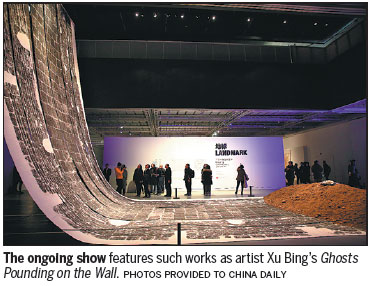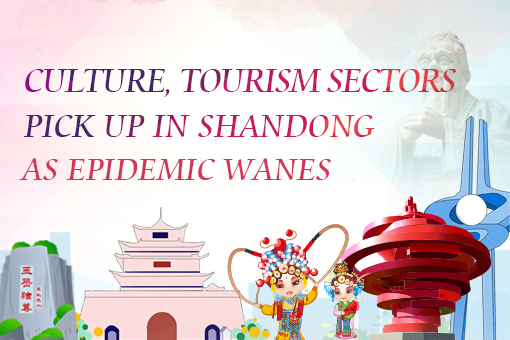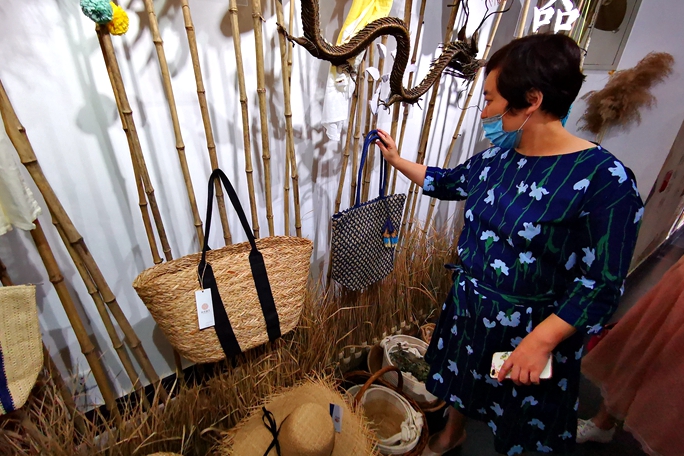Exhibition traces evolution of contemporary art in China
In 1991, Chinese artist Xu Bing held his first exhibition in the United States at the University of Wisconsin with his iconic large-scale installation Book from the Sky and Ghosts Pounding on the Wall.
The former was made up by thousands of Chinese characters and the latter was prints created from bricks from the Great Wall. The exhibition won international attention for the artist.
Xu's show in the US sparked a spirited discussion in China on contemporary art, a concept introduced to China in the 1980s that many Chinese art critics thought was a kind of invasion, says Zheng Shengtian, an experienced curator who attended Xu's show.
Meanwhile, Zheng has used Xu's work Ghosts Pounding on the Wall in a show, which opened on Saturday at Beijing's Guardian Art Center, as a way to showcase the birth of Chinese contemporary art.
The work has been displayed along with the works of 14 renowned Chinese artists who have made their mark in the past 30 years.
The show, titled Landmark: Mapping Contemporary Chinese Art, has works by established artists like Cai Guoqiang, who's known for his gunpowder works, and Cao Fei, who gained fame for her video and mixed media works.
Explaining his reasons for choosing the works, Zheng says he wants to show the development of Chinese contemporary art by displaying key art works from the past 30 years, and to show how changes that happened in China were recorded by artists through their works.
"I put the word landmark in the title because each piece is more or less a site-specific work," adds Zheng.
For instance, Xu's work Ghosts Pounding on the Wall involved the Great Wall, and transferring the bricks' pattern onto wall paper.
The name of Xu's work is Chinese slang that means wherever a person goes, he will walk back to where he begins, just like being tracked by a ghost.
Xu's show in the US was like telling the world that China also had contemporary art, says Zheng, adding: "For many years, Chinese artists produced works with a mission or burden to introduce China to the world. However, after 2000, many shifted their focus to social issues."
Liu Jianhua's Yiwu Survey focuses on the export trade, a pivotal move for China's economy in the 2000s.
In the work, Liu produced a container of goods made in Yiwu in Zhejiang province, a city that attracted thousands of businessmen from across the globe for its small commodities.
The container is open, with goods - such as plastic trash buckets, coat hangers, toothbrushes and swing rings - falling out.
The Shanghai-based artist says he made several visits to Yiwu and was stunned by the scale of goods shipped to cities across the world and the number of businessmen from various countries there.
"I felt clearly the pace of economic development when I was in Yiwu, as well as the connection between China and the world," says Liu.
In Yu Hong's work Girls of Baota Mountain, the oil painter depicts a phenomenon she discovered during her visit to Yan'an in Shaanxi province, a city that was once home to the central government of the Communist Party before 1949.
In her picture, a girl dressed like a soldier poses for a photographer in front of a landmark in Yan'an.
"The pagoda in Yan'an was a sign of China's revolution. Now people treat it as a tourist landmark," says Yu Hong.
Three other artists, who were from younger generations, concentrated on factory workers.
Video artist Yang Fudong used five screens to show the lives of miners in Shandong province while multimedia artist Cao Fei trained her lens on factory workers in the southern part in China where there are factories that produce goods exported to other countries.
The youngest among the three, Sun Xun, made a 3-D short movie Time Spy inspired by his visits to watch factories in Switzerland.
If you go
10 am-6 pm, through Jan 31. Guardian Art Center, 1 Wangfujing Street, Dongcheng district, Beijing. 010-6518-9968.
dengzhangyu@chinadaily.com.cn

|
Huang Min’s lightbox installation, Landscape/Scenery, features people viewing the Song Dynasty (960-1279) masterpiece, A Panorama of Rivers and Mountains, at a show in Beijing’s Palace Museum. |
(China Daily 12/19/2017 page18)


 Shandong Culture and Tourism Consumption Season
Shandong Culture and Tourism Consumption Season Culture, tourism sectors pick up in Shandong as epidemic wanes
Culture, tourism sectors pick up in Shandong as epidemic wanes

